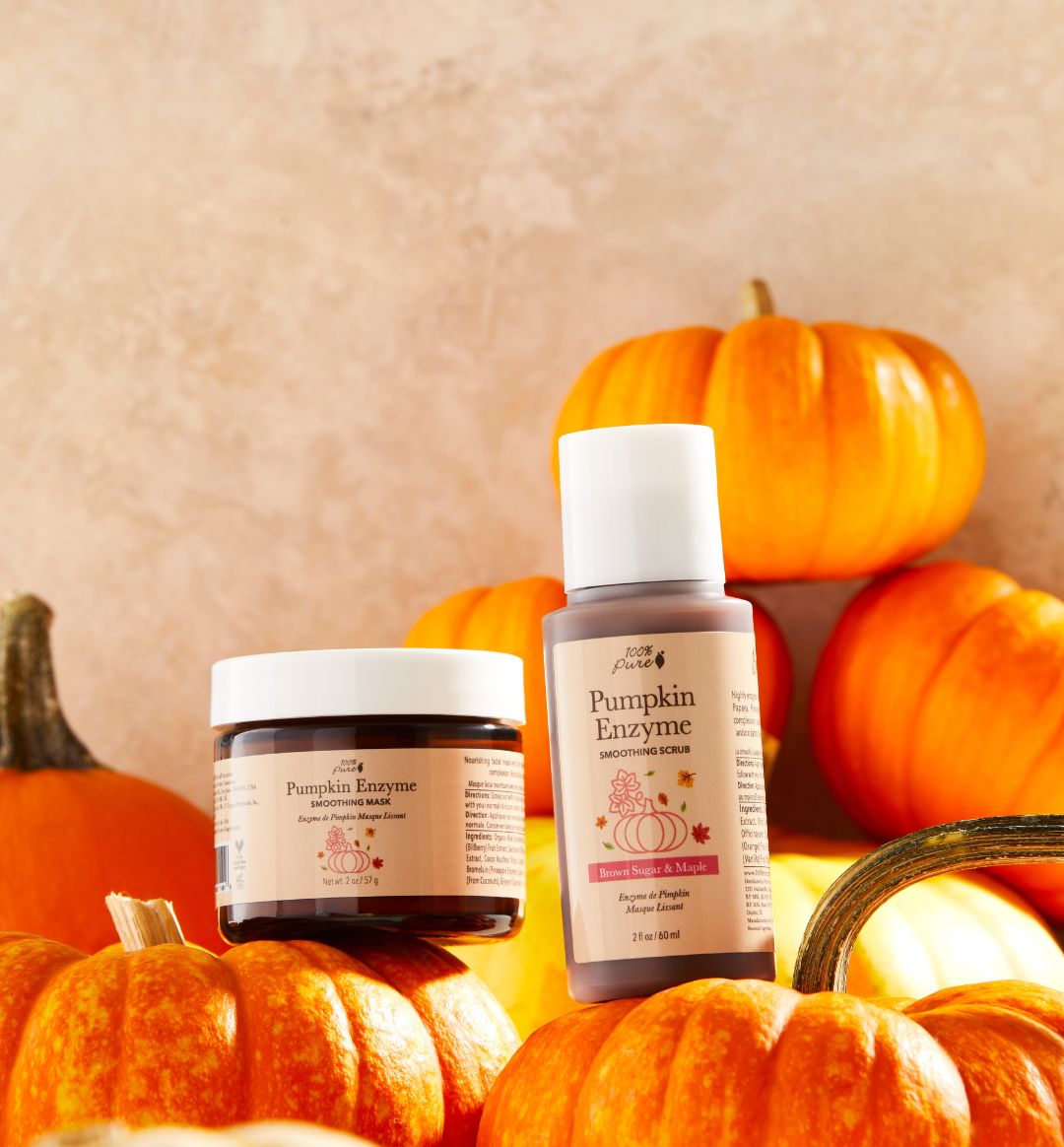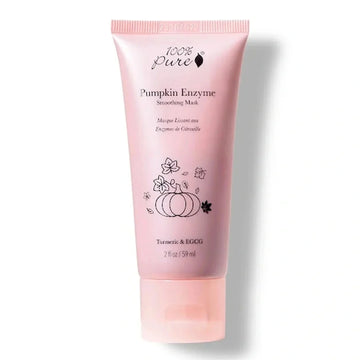Can enzymes help you get smooth, glowing skin? Let’s find out.
Written by: 100% PURE ®
If you’ve been a skincare fanatic over the past few years, you may be all too familiar with exfoliation.
Exfoliation is an excellent way to clarify, renew, and soften your skin, since the process involves sloughing away dead skin and sebum, freeing up clogged pores and revealing a radiant glow. It’s no wonder why AHAs (alpha-hydroxy acids) and BHAs (beta-hydroxy acids) have gained so much popularity as of late.
But in the past year, more and more of us are becoming burnt out on the acid exfoliation, and many of us are doing it too often, which can result in skin sensitivity, irritation and redness.
If you love the benefits of exfoliating, but don’t love the burn that comes with acids, we present an alternative: enzymes!
As plant-derived microorganisms, enzymes work to gently exfoliate the skin’s surface with minimal irritation, and it can contribute to a more even skin texture, a clear complexion, and a healthy glow.
If you’re still new to enzyme exfoliation, we have just the guide for you. Here, we’re sharing all the know-how behind enzymes in skincare: what they are, what they do, and how you can use them for your best skin yet.
To better understand how enzymes work in your skincare, it helps to first break down what they do for the body.
Enzymes are a type of living organism–specifically, a protein contained within a cell, and it works by accelerating the process of chemical reactions which, in turn, provide support for essential bodily functions like detoxifying, muscle building, and digestion.
These tiny organisms are naturally occurring in the body, and eating a diet that’s rich in protein and healthy fats can also boost enzyme activity.
On top of that, your body’s health overall will have an impact not only on enzyme production in the body, but also the way it stores and releases them.
Now that we know a little more about what enzymes do for the body, you might be wondering what they do for the skin.
Enzymes in skincare are mainly derived from fruits, and when used on the skin, they tend to work wonders.
Enzymes on the skin break down and “eat” the keratin on the outer layer. Keratin is like the glue that keeps dead skin on our faces, so as enzymes break down the keratin, it’s easier to slough away those dead skin cells to reveal smoother, softer skin.
Through this gentle exfoliation process, enzymes accelerate cell turnover, which helps free up clogged pores to promote clear, radiant skin.

When it comes to enzymes in skincare, you’ll find a wide variety of options, but there are three we tend to see the most often: proteolytic, Coenzyme Q10, and superoxide dismutase.
Proteolytic enzymes are known for their ability to break down skin proteins while encouraging cell turnover. The most often-used proteolytic enzymes in skin care include bromelain, which is found in pineapples, and papain, which comes from papaya.
Coenzyme Q10 is naturally occurring in the body, and its production tends to decrease as we age. That’s why when it comes to rejuvenating the skin, Coenzyme Q10 often comes up, and it’s been gaining popularity in recent years.
Superoxide dismutase is another enzyme found naturally occurring in the body, and it, too, decreases in production as we age. Superoxide dismutase is a potent antioxidant, and it’s often paired in a formulation with the enzyme catalase to help prevent wrinkle onset while improving the appearance of fine lines and scar tissue.
Newsletter Subscribe
for more blog updates and exclusive discounts
If you’re looking for a quick burst of results–whether it’s for a special occasion, wedding, or photo op, a peel is going to be the thing that will provide that instant glow.
While we typically talk about chemical peels, which usually contain a combination of AHAs like glycolic acid and lactic acid, and BHAs like salicylic acid, enzyme peels also make an excellent option.
Why?
While chemical peels containing acids are notorious for their sensitizing effects, enzymes offer a gentle, yet effective alternative. While chemical peels impact multiple layers of the skin, an enzyme peel will focus its properties on the top layer, where it feasts on the keratin that’s keeping dead skin bonded together.
When it comes to choosing between a chemical peel and an enzyme peel, it will also depend on the individual and their skin type.
Because enzymes are so gentle, they’re ideal for those who have had bad experiences with peels in the past. Additionally, they make a fantastic option for those who are new to exfoliating, and feel nervous about putting acids on their skin.
Enzyme peels are also a great option because they can be performed far more frequently than chemical peels. They’re also a great choice for pregnant and nursing mothers, since chemical peels are not a viable option.
Skincare products with a high concentration of enzymes are suited for most skin types with most concerns. Enzymes are even a great option for those with skin sensitivity, since their exfoliating properties are so gentle.
If your skin is on the dry and/or sensitive side, incorporating enzymes could be a great change to your skincare routine, since they offer a gentle, non-inflammatory way to polish and exfoliate your skin. For this purpose, enzymes also make a great swap for acids when you’re pregnant.
Those with oily/acne-prone skin, on the other hand, may need something a bit more intense like BHAs (beta-hydroxy acids), since enzymes don’t really exfoliate within the pore.
If you’re still not sure whether to go with an acid or an enzyme, it’s worth noting that these two ingredients may actually work best when used together.
When an enzyme/acid product is well formulated, it can exfoliate the surface extremely well, although they must usually be stored in a specific way.
The concentration of enzymes and the temperature of the product must be in the right range, as poor storing conditions can lead to the product’s rapid reduction in potency.
The bottom line is that an enzyme peel is going to gently polish the skin’s surface, while acids can help clear out the pores, although they can be irritating for those with sensitive skin.
Meanwhile, many may benefit from the double-whammy you get from combining an acid with an enzyme, but it needs to be a high-quality product, and proper storing is essential.

To get the most out of enzymes in your skincare regimen, it’s key that you take proper care of your enzyme products, whether it’s a peel, scrub, or mask.
Typically, you’ll notice that enzyme peels are derived from plant-based foods like pumpkins and yams, since enzymes are derived from fruits and vegetables. As a result, enzymes in skin care tend to have a short shelf life. This is when a skincare fridge comes in handy, although your kitchen fridge will certainly do the job.
For a gentle alternative to an enzyme peel, we recommend an enzyme mask–specifically, our Pumpkin Enzyme Smoothing Mask.
Made with enzymes derived from pumpkin, papaya, and pineapple along with fruit-derived AHAs, this nourishing mask works to even the appearance of the skin while smoothing out fine lines and wrinkles to reveal a healthy, radiant glow. Not only is it gentle and effective, but it’s highly versatile, since the combination of AHAs and enzymes work your skin from all angles. If you need the ultimate refresh for fine lines, wrinkles and dullness, look no further!
- Tags: October-2022
We carefully hand-select products based on strict purity standards, and only recommend products we feel meet this criteria. 100% PURE™ may earn a small commission for products purchased through affiliate links.
The information in this article is for educational use, and not intended to substitute professional medical advice, diagnosis, or treatment and should not be used as such.


